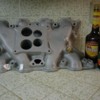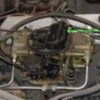quote:
Originally posted by accobra:
...Would the records be on file at the Plant in Modena...
Yes, the factory has records of Post Ford Era cars! Believe it or not. lol.....
The intake in your pic is the '73 - '74 version, designed for exhaust gas recirc, hence the channel that is cast into the front & right side of the carb pad. deTomaso has elongated the secondary holes to allow it to be used with the square bore Holley carb, strange!
You have a myriad of carb & intake choices. It depends what you want to do with this car. I'll cover just a few. I'll asssume you do not want to install exhaust gas recirc! If you want to run the 4300D carb, the '72 Cobra Jet manifold is identical to the manifold in your picture, excepting it has no channel for EGR. I see 4300D carbs on ebay frequently.
There is also an aluminum version of that manifold, the Boss 351 manifold, casting number D1ZX-9425-CA (see mine in the pic below).
In the early days of the smog era in California I built many very strong engines with the 4300D carb. I know it will support 400 bhp. What its limits are I haven't heard. I'm running the 4300D on my motor.
The cast iron square bore manifold is identical in design to those manifolds, except it has four small holes that fit an Autolite 4300A or Holley 600 cfm carb. There is no channel for exhaust gas recirc either. The holes can be machined larger for a larger Holley, Demon or Edelbrock carb. This was a very common mod long ago. An aluminum version of this intake also exists, casting number D1ZX-9425-DA.
All these manifolds perform the same, the cast iron manifolds weigh about 50 pounds, the alloy manifolds weigh about 20. The cast iron intakes are available on ebay constantly, I don't follow the prices, but I would assume they go for $100 or less. The alloy manifolds go for $300 and up. Some guys want $500 or more, (dream on buddy). They are a bit harder to locate.
Those dual plane Ford manifolds plus the Edelbrock Performer have the lowest carb mounting pads, making installation below the engine screen the easiest.
The Shelby intake you saw is identical to the Blue Thunder intake, it raises the carb about an inch, which is about as high as you can go and keep the engine screen on. It will require a drop base air filter assembly. These intakes will make more power above 5000 rpm than the Ford intakes, up to 40 bhp depending upon your combination. Below 5000 rpm don't expect any differences, there are none.
Your friend on the DTBB




